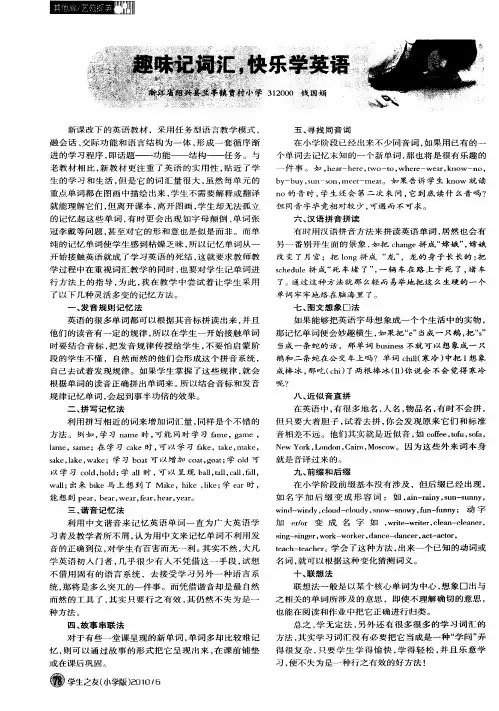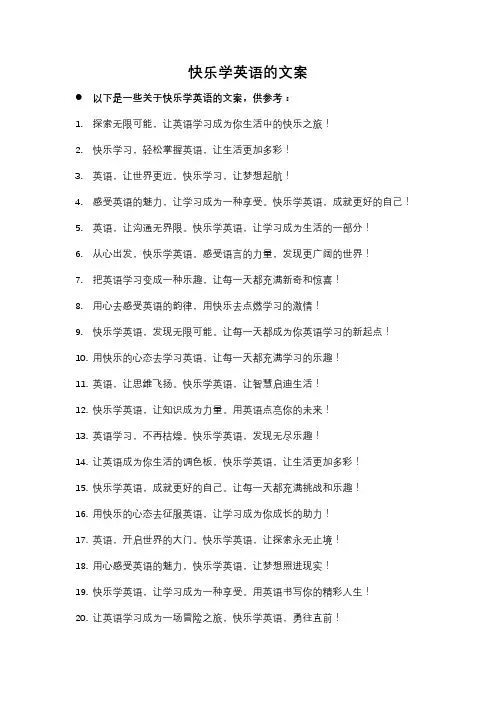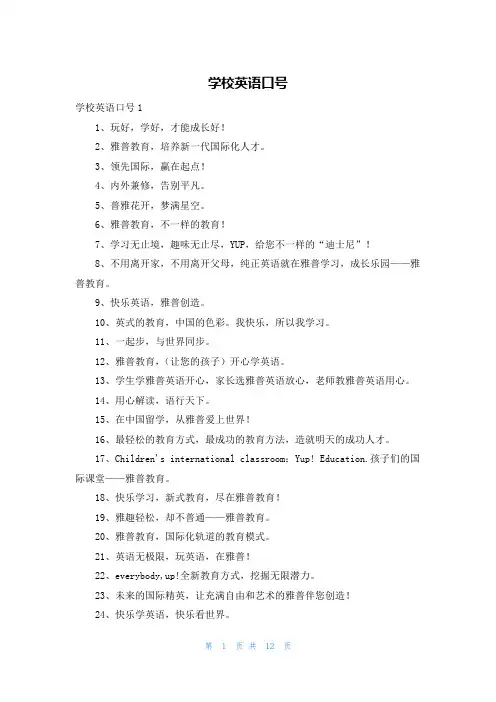快乐学英语
快乐学英语论文

快乐学英语英语作为一门新兴的综合性学科,跨进了小学的课堂。
由于小学英语面对的对象是小学生,小学生年龄小,注意力不易集中,意志力较为薄弱。
一旦教学内容枯燥,教学方法单板,节奏慢,就会出现做小动作,在底下小声讲话等不良习惯。
陶行知说:“唤起兴趣,学生有了兴趣,就肯用全副精神去做事情,所以‘学’和‘乐’是不可分离。
”又说“治学以兴趣为主,兴趣愈多,则从事弥力,从事弥力则成效愈著。
”学生对问题产生了浓厚的兴趣,便会锲而不合地进行思考和探索。
我们教师应充分利用小学生活泼好动,爱表现,无意注意等特点,因势利导,尽可能将枯燥无味的语言装化为有趣的活动形式,从而激发学生的思维,提高学生的兴趣。
变“要我学”为“我要学”。
下面我就结合自己几年的英语教学谈谈自己的感受和理解。
一、我们必须营造一种和谐的气氛,让学生在轻松愉快的环境中学习英语。
只有在和谐宽松的课堂气氛中,才能使学生们怀着轻松愉快的心情投入学习,才敢于用英语大胆发言,积极思维,从而产生学习英语和施展才能的兴趣。
如在课堂的导人部分就可设置一些悬念来调调学生的胃口,这样学生的思维就会跟着老师转了,这要比直接出示本课所教授的内容要好得多。
如果直接出示,学生一看就明白老师要教什么,没有新意,学生的兴趣当然就提不起来了。
有一课是关于香蕉这一内容,于是我制作了一个guess game的课件,用它来引出课题。
即让学生看大屏幕,开始大屏幕中央是一点点黄色,然后让学生来猜:“what’sthis?”这时学生的答案有很多:it’s apear/lemon/mango/banana,…--等,然后用右手按动鼠标,黄色的范围渐渐扩大,再让学生猜,这时学生的答案也有多种,最后,再次按动鼠标,学生基本上可以看到香蕉的全貌,猜对的学生兴趣盎然,欢呼着喊道:“yeah”,学生情绪高涨。
二、充分利用多媒体实行情境教学随着科技的发展,社会的进步,过去的“一支粉笔十一本书”的课堂模式已经不能满足现代教学的需要。
趣味记词汇,快乐学英语

生 的学 习 和 生 活 , 是 它 的 词 汇 量 很 大 , 然 每 单 元 的 但 虽 重 点单 词都 在 图 画 中描 绘 出来 , 生 不 需 要 解 释 或 翻 译 学 就 能 理解 它 们 , 离 开 课 本 , 开 图 画 , 生 却无 法 孤 立 但 离 学 的 记 忆 起 这 些 单 词 , 时 更 会 出 现 如 字 母 颠 倒 、 词 张 有 单 冠 李戴 等 问题 , 至 对 它 的 形 和 意 也 是 似 是 而非 。 而单 甚 纯 的 记忆 单 词 使 学 生 感 到 枯 燥 乏 味 , 以 记 忆 单 词从 一 所
新课 改 下 的英 语 教 材 ,采 用 任 务 型 语 言 教 学 模 式 , 融 会 话 、 际 功 能 和语 言 结 构 为 一 体 , 成 一 套 循 序 渐 交 形 进 的学 习 程 序 , 即话 题 — — 功 能 — — 结 构— — 任 务 。 与
老 教 材 相 比 , 教 材 更 注 重 了英 语 的 实 用 性 , 近 了 学 新 贴
时 要 结 合 音 标 , 发 音 规 律 传 授 给学 生 , 要 怕 启 蒙 阶 把 不
段 的学 生 不 懂 , 自然 而 然 的他 们 会 形 成 这 个 拼 音 系 统 ,
那 记 忆单 词 便 会 妙 趣 横 生 , 果 把 … ’ 如 e 当成 一 只鹅 , … ’ 把 s 当成 一 条 蛇 的话 , 那单 词 b s e 不就 可 以 想 象成 一 只 ui s n s
八 、 似 音 直拼 近
在英 语 中 , 很 多 地 名 , 有 人名 , 品 名 , 时 不 会 拼 , 物 有 但 只 要 大 着 胆 子 , 着 去 拼 , 会 发 现 原 来 它 们 和标 准 试 你 音 相 差 不 远 。 他 们 其 实 就 是 近 似 音 , cf e t u sf, 如 o e , f , a o o N w Y r , n 0 , a o Moc w 因 为 这 些 外 来 词 本 身 e ok d n C i , so 。 r
快乐学英语的文案

快乐学英语的文案
以下是一些关于快乐学英语的文案,供参考:
1.探索无限可能,让英语学习成为你生活中的快乐之旅!
2.快乐学习,轻松掌握英语,让生活更加多彩!
3.英语,让世界更近。
快乐学习,让梦想起航!
4.感受英语的魅力,让学习成为一种享受。
快乐学英语,成就更好的自己!
5.英语,让沟通无界限。
快乐学英语,让学习成为生活的一部分!
6.从心出发,快乐学英语。
感受语言的力量,发现更广阔的世界!
7.把英语学习变成一种乐趣,让每一天都充满新奇和惊喜!
8.用心去感受英语的韵律,用快乐去点燃学习的激情!
9.快乐学英语,发现无限可能。
让每一天都成为你英语学习的新起点!
10.用快乐的心态去学习英语,让每一天都充满学习的乐趣!
11.英语,让思维飞扬。
快乐学英语,让智慧启迪生活!
12.快乐学英语,让知识成为力量。
用英语点亮你的未来!
13.英语学习,不再枯燥。
快乐学英语,发现无尽乐趣!
14.让英语成为你生活的调色板,快乐学英语,让生活更加多彩!
15.快乐学英语,成就更好的自己。
让每一天都充满挑战和乐趣!
16.用快乐的心态去征服英语,让学习成为你成长的助力!
17.英语,开启世界的大门。
快乐学英语,让探索永无止境!
18.用心感受英语的魅力,快乐学英语,让梦想照进现实!
19.快乐学英语,让学习成为一种享受。
用英语书写你的精彩人生!
20.让英语学习成为一场冒险之旅,快乐学英语,勇往直前!。
寓教于趣融学于乐——让小学生快乐学英语

186课堂内外简谈农村小学英语课堂教学的有效方法陈尚松(江西省永修县虬津镇中心小学,江西 永修 330309)摘要:农村小学也是研究有效教学方法的隶属之地。
但是,长期以来,很多教师仅仅关注到城市英语教学,而忽视了农村英语教学。
这让我们农村小学英语课堂举步维艰。
针对此,笔者在本文中阐述了一些个人的观点和看法,希望对同仁有所帮助。
关键词:小学;英语课堂;农村学校本文针对农村小学英语课堂,儿童学习兴趣不足,学习质量有待进一步提高以及教师与学生交流关系紧张等问题,展开了笔者自己的一些探讨,希望可以对同仁有所帮助。
一、结合多媒体教学方法,激发儿童英语兴趣虽然,农村小学较之城市的学校来说,整体教学资源不足,教学技术较为落后,但是,随着我国近些年来对教育事业的投入力度,坚持实施“科教兴国”与“人才强国”的伟大战略,可以看到我国近几年来基础教学改革已经初具规模,一批又一批信息化的多媒体教学设备在实践中的利用,就是最好的证明。
结合多媒体教学技术,可以让小学英语课堂变得更加生动、活泼和有趣。
比如,在指导学生进行单词记忆和背诵的过程中,我们就可以结合英语歌曲进行启发,《26英文字母歌》、《Head Shoulders Knees and Toe》以及《God is a girl》等都可以让儿童在聆听美妙的音律同时,享受到英语学习高效和成功的乐趣。
又如,在教学《Food》一课时,我们还可以利用课下的时间制作多媒体动画片“朋友来我家”,如在“have breakfast”、“have lunch”的情景让学生学会简单的英语对话,激发他们练习英语口语的兴趣,进而提升农村小学英语课堂教学的有效性。
二、实施小组合作,融洽师生、生生关系针对当前农村小学英语课堂教学质量有待进一步提高的问题,笔者认为,我们还需要结合小组合作的教学方法,让课堂质量变得高效起来。
传统的“教师讲+学生听”的模式,显然是背离儿童自主发展规律的,教师与学生的关系一再紧张,班级内部更出现“两极分化”的现象,想要提升教学的有效性更是难上加难。
学校英语口号

学校英语口号学校英语口号11、玩好,学好,才能成长好!2、雅普教育,培养新一代国际化人才。
3、领先国际,赢在起点!4、内外兼修,告别平凡。
5、普雅花开,梦满星空。
6、雅普教育,不一样的教育!7、学习无止境,趣味无止尽,YUP,给您不一样的“迪士尼”!8、不用离开家,不用离开父母,纯正英语就在雅普学习,成长乐园——雅普教育。
9、快乐英语,雅普创造。
10、英式的教育,中国的色彩。
我快乐,所以我学习。
11、一起步,与世界同步。
12、雅普教育,(让您的孩子)开心学英语。
13、学生学雅普英语开心,家长选雅普英语放心,老师教雅普英语用心。
14、用心解读,语行天下。
15、在中国留学,从雅普爱上世界!16、最轻松的教育方式,最成功的教育方法,造就明天的成功人才。
17、Children's international classroom:Yup! Education.孩子们的国际课堂——雅普教育。
18、快乐学习,新式教育,尽在雅普教育!19、雅趣轻松,却不普通——雅普教育。
20、雅普教育,国际化轨道的教育模式。
21、英语无极限,玩英语,在雅普!22、everybody,up!全新教育方式,挖掘无限潜力。
23、未来的国际精英,让充满自由和艺术的雅普伴您创造!24、快乐学英语,快乐看世界。
25、让孩子沐浴在自由的天空中。
26、把美种在讲台上,让孩子们去收获吧——雅普,一个给教育事业以生命和灵魂的学校。
27、让我们帮助您聆听世界的声音——雅普教育。
28、雅普教育,娱乐加学习,让你的孩子轻松掌握英语!29、东方之雅,普泽全球!学之乐极,尽在YUP!30、英语、艺术、国际化,少儿玩乐中长大——雅普教育!31、融入世界的起点,接轨国际的桥梁——雅普英语!32、雅普教育,寓教于乐!33、选雅普,做主人。
34、走进哈佛,从雅普开始。
35、出国的教育,年轻的`天地。
36、雅普教育——给孩子智慧的眼睛。
37、雅普教育——从这里看到未来。
如何快乐学英语

浅论如何快乐学英语“兴趣是最好的老师”,学生只有有了兴趣,他才会乐于学、主动学,所以教师应努力创造一种轻松、愉快、和谐、平等的课堂学习氛围。
课堂活动教学在吸收了传统教学的优点的同时,还应融入任务型教学活动,来进一步完善英语学科教学体系,使英语学科课堂教学更能体现学生学习的主体性和创造性,并且也自然而然地融入了新课程的理念。
由于小学英语教学面向的教育对象是小学生,小学生年龄小,注意力不易集中,意志力较为薄弱,让小学生快乐学英语,通过创设愉快的学习环境可以激发学生浓厚的学习兴趣和强烈的求知欲望,变“要我学”为“我要学”,培养学生爱学的情感,会学的能力,在发展中求愉快,在愉快中求发展,从而自主的学习,达到提高教学质量的目的。
小学英语教材的独特优势是实施快乐英语教学的有利条件。
在小学英语的教学中,我们要让学生快乐地学习英语,让独特的英语教育具体落实在语言教学实践中。
多元智能理论的特征是对所有学生都抱有热切的成才期望,充分尊重每一个学生的智力特点,使我们的教育真正成为“愉快教育”和“成功教育”。
这样就需要针对不同学生和不同智力特点进行“对症下药”的教育教学。
新课程的基本理念是以学生发展为本,新课程带给学生的是全新的面孔与思维方式,而带给老师的是全新的挑战,教的过程其实也是学的过程。
面对素质教育的今天,这就势必要求我们教师要创设适合学生学习的高效率的教学课堂。
要想学好英语,必须做到“听,说,读,写,译”全面发展,但中国学生学习英语缺乏英语语言环境,在班级中,总能找到这样的学生,笔头功夫顶呱呱,笔试成绩遥遥领先,但一落实到张嘴讲,上台马上脸红,结结巴巴讲不出几句英语来,既胆怯,又有自卑感。
还有些同学上课回答问题时,其他同学常常要笑他们。
究其缘由,主要是学生始终接受的是被动型英语教育,学的是“哑巴英语”。
针对这种现状,我采取了几项相应可行的解决此问题的措施,来激发同学们学英语,讲英语的兴趣,从而使学生在快乐中学习英语,并令学生们由衷的感到学英语是快乐的。
暑假专题——快乐学英语
年级五年级学科英语版本人教PEP版内容标题暑假专题——快乐学英语编稿老师魏秀然【本讲教育信息】一、教学内容(一)英语是世界上使用最广泛的语言,对于中国学生来说,很多人都梦想讲一口流利的英语,但是很多人不敢开口,怕犯错误,怕丢脸。
其实不用怕,我们又不是生长在说英语的国家,说不好是很正常的,没人会笑话你。
做任何事情都需要毅力,学习英语也不例外,只要每天不断练习,日积月累,就能学好。
英语课堂上,不要把发言机会让给任何人,每次都要把手给举直了,增加在众人面前开口的机会,可以积累你的自信心和成就感。
另外,在日常学习中应做到听说读写相结合,循序渐进,相信你对英语的兴趣会日渐浓厚起来。
听是一种感觉,是一种意识,是建立在词汇量基础上的能力。
重复听,什么都听,建议从听英语歌曲开始。
说是最难掌握的技巧,没有捷径,只能靠反复说。
早期跟着磁带大声朗读就行了,尽量去模仿标准的语音、语调,口语交际能力也可以得到加强。
读,模仿是关键,一定要大声,这个很重要,口语和听力都靠“读”来提高。
写还得靠阅读,读得多了,自然就有感觉。
听说读写是一个环环相扣的整体,只要一个方面提高了,其他方面也会相应加强的。
建议从最简单的阅读入手,循序渐进,切记是海量阅读,多读英语课外读物。
总之,每个人都有适合自己的学习方法。
平时,录音机和课外读物是同学们学英语最好的帮手,学习英语很艰苦,也充满乐趣,途中肯定会遇到挫折和失败,只要习惯于挑战失败,就没有什么可以把你击倒。
试想一下,说一口流利的英语是什么感觉,^_^。
Come on! It’s so easy to learn English!(二)开心一笑In England, people under the age of eighteen can’t drink in a public bar.Mr. Smith goes to bar near his house quite often, but he never takes his son, Tom, because he is too young. After Tom’s eighteenth birthday, Mr. Smith takes him to the bar for the first time. They drink for an hour, and then Mr. Smith says to his son, “Now, Tom, I want to tell you not to drink too much.’’ The son asks, “How do I know when I have enough?”“Well, let me tell you. Doyou see those two lights at the end of the bar? When they seem(似乎) to become four, you have enough,” his father says.Tom says, “But I can only see one light there.”练一练( ) 1. A public bar is a room for people to _________.A. see a filmB. count lightsC. get something to drinkD. have a rest( ) 2. Tom’s father doesn’t take him to the bar because_________.A. Tom is youngB. he doesn’t like TomC. Tom doesn’t like to drinkD. Tom can’t drink too much( ) 3. Tom can see only one light because ______________.A. Tom’s eyes are not very goodB. there’s only one lightC. the bar is very darkD. someone takes away one light( ) 4. How many lights are there at the end of the bar?A. OneB. TwoC. ThreeD. Four( ) 5. In England, people under the age of ______ can’t drink in a public bar.A. 15B. 16C. 17D. 18(三)Story time讲故事The Tiger and the CatIn China, people believe that, at the beginning, the tiger and the cat were friends, and the cat was much smarter than the tiger .The cat learned the physical skills quickly, and the tiger was always behind. Gradually(渐渐地), the tiger had to learn from the cat, and the cat was patient (耐心的)to teach the tiger. Day after day, month after month, finally, the tiger could also run, jump, roll, grasp(扑抓), tear(撕咬), and strike(攻击)as well as(像……一样)the cat.One summer afternoon, the cat was taking a nap(打盹)as the tiger sitting nearby. Looking at the cat, the tiger suddenly thought, why should he keep befriending with such a small animal since he had already learnt all the skills from the cat? The evil(邪恶的)tiger decided to(决定)kill the sleeping cat as a before dinner snack. The tiger stood up and approached (靠近) the cat viciously (凶恶地). Just as this moment, the cat woke up. Opening up her eyes, the smart cat immediately (马上、立即)realized(领会、认识)what the tiger was trying to do and swiftly(迅速地)jumped onto a nearby tall tree and climbed to the top branch.The tiger thought he had already learned every skill from the cat .But he never knew that the cat had hidden the tree climbing from him.“I kept the last technique(技能)of the tree climbing from you just because I suspected(怀疑)you might be an ungrateful(忘恩负义的)friend.” The cat loudly told the tiger who watched under the tree helplessly(无奈的、无助的).真诚地对待朋友,做一个知恩图报的人。
以快乐学英语为主题的英语教研活动方案
以快乐学英语为主题的英语教研活动方案全文共6篇示例,供读者参考篇1Learning English Can Be Super Fun!Hi friends! My name is Emma and I'm a 4th grader. Today I want to tell you all about how we've been learning English in such a fun way at my school. I used to think English class was kind of boring, but not anymore! Our teachers have come up with the most awesome activities to make learning English an absolute blast.It all started at the beginning of this school year when my English teacher, Ms. Roberts, told us we were going to have an "English Fun Club" once a week instead of our regular English class. She said the goal was to make learning English something we actually looked forward to and enjoyed. I wasn't sure what to expect, but I was definitely excited at the idea of English being fun!The first fun activity we did were English tongue twisters. I'll be honest, at first I thought tongue twisters were kind of silly. But Ms. Roberts had us going around the room trying to say thingslike "She sells sea-shells by the sea-shore" as fast as we could without messing up. We all cracked up laughing at each other's blunders. Then we had a tongue twister contest to see who could say the hardest ones perfectly. It was hilarious but it also helped me practiced pronouncing difficult English sounds.Another time, Ms. Roberts brought in all these random objects like a rubber duck, a pinecone, a pasta strainer, and some other weird items. She put them all on a table and we had to go around naming each object in English and making up a silly sentence using the word. The sentences we came up with were so ridiculous and funny. But it really helped me practice using new vocabulary words in context. Now whenever I see a rubber duck, I think about the goofy sentence I made up and it helps me remember the English word.My favorite English Fun Club day so far was when we played English Charades. Ms. Roberts put different English words and phrases into a hat and we took turns picking one out and acting it out for the rest of the class to guess. You're not allowed to talk at all, so we really had to flex our acting muscles! I had no idea how challenging it would be to act out something like "going shopping" without using any words. My whole class was dying laughing at my over-the-top performances. I loved seeingeveryone's creativity in action as they mimed out words and scenes. It felt more like a comedy club than an English class!Sometimes we also sing crazy English songs where we make up the lyrics as we go using certain vocabulary words or grammatical concepts Ms. Roberts wants us to practice. We'll start with a simple phrase like "I am smart" and then each person has to make up another line that follows logically. Before you know it, we have an epic (and totally nonsensical) song! Singing and dancing around as we belt out the goofy lyrics helps reinforce what we're learning in such a fun, energetic way.Ms. Roberts also taught us some super engaging English games to play. One is called "Sundae Silliness" where you build an imaginary ice cream sundae by going around the circle saying different toppings in English. Whenever someone messes up or repeats a topping, they're out! The last person standing wins. It's a simple idea but gets everyone shouting out English words at a rapid pace. You really have to think fast.Another great game is called "Secretary" where one person runs out of the room and everyone else picks a random English vocabulary word for them to guess. When the Secretary comes back in, they have to fire off different questions to the group to try and guess what the word is based on our yes/no responses.It's neat because it gets you putting your English into action and thinking of creative ways to describe something.I could go on and on about all the cool English learning games and activities we've done, but I think you get the point - my English Fun Club is awesome! What makes it so effective is that we're always being challenged to actually use the English we're learning, not just memorize facts or vocabulary lists. The interactive and collaborative nature of the activities forces me to get out of my comfort zone communicating only in English.Probably the biggest benefit though is that these engaging games and activities have completely changed my attitude towards learning English. I used to see it as this boring grammar-focused subject. Now, I associate it with laughter, creativity, and flat-out fun. I find myself actively looking for opportunities to practice my English, maybe by telling silly jokes to my parents or writing wacky stories with my friends. The fun vibe of my English Fun Club has motivated me to take my English learning beyond the classroom.I really hope lots of other schools start doing an English Fun Club like ours. It's such an effective way to build vital communication skills in a low-pressure, high-energy environment. Who knew learning English could be this awesome?I may only be in 4th grade but I already feel like I'm becoming fluent thanks to all the hands-on speaking,篇2Learning English with Joy!Hi everyone! My name is Emma and I'm a 4th grader at Sunnyville Elementary School. Today I want to share with you all an amazing English lesson our teacher Miss Wilson did with our class last week. It was so much fun and helped us learn new words and practice our English in a totally joy-filled way!The lesson was called "Learning English with Joy" and it had lots of cool activities and games. I can't wait to tell you all about it!It started with Miss Wilson putting us into teams of 4 students each. She said we were going to go on a "Word Safari" to hunt for new vocabulary words. How exciting! Each team got a list of 15 words we had to find definitions and example sentences for.But here's the best part - we couldn't just look them up online or in a dictionary. No way! We had to search for clues around the classroom and playground by following a treasuremap Miss Wilson gave us. Underneath chairs, behind bookcases, under the jungle gym - the clues could be anywhere!My team found clues like "I make a crunch when you step on me" (the word was "leaf") and "I'm cold, white, and I fall from the sky in winter" (can you guess that one?). We had to use the clues to figure out what each word meant.After 30 minutes of clue hunting, we came back together as a class and each team presented the words they had found. We got to use gestures, draw pictures, act things out - whatever helped us describe the meanings in English. It was like a fun gameshow!I'll never forget words like "agile" (moving quickly and easily) because my teammate did this hilarious acrobatic move to act it out. Such a smart way to learn vocabulary!Next up was the "Story Switcheroo" game. Miss Wilson put us in new teams and gave each team the beginning line of a story. Our job? To go around in a circle and have each person add just ONE sentence to continue the tale.The stories started normal like "Once upon a time, there was a girl named Lily who lived in a treehouse." But they quickly became the wackiest tales like "...Lily's treehouse was a spaceship.One day, she was abducted by aliens and taken to their planet made of chocolate..." You can imagine how silly they got!Not only did we have a blast trying to one-up each other with our creative sentence additions, but we also practiced so many English skills. We had to listen carefully to what the previous person said to make our sentence make sense and move the story forward. Such great reading comprehension and speaking practice!After all the morning's high-energy games, we settled down for my favorite part of the lesson - the "World Voices" showcase. For this, Miss Wilson had recorded native speakers from around the world reading the same simple paragraph in their varieties of English.We heard accents from Australia, India, South Africa, Jamaica, and more. As we listened to each one, we had to identify on a map where that variety of English was from. It was so cool to hear the differences in pronunciation, word stress, and even some vocabulary between all the Englishes!Miss Wilson reminded us that there's no single "correct" English - it's a global language with lots of diversity. She said we should celebrate the variety we heard in the recordings and beopen-minded to different accents and dialects. What a valuable lesson about English being the world's lingua franca!To wrap up the amazing day, we made "Joy Journals" - little blank booklets where we wrote down our favorite new words, phrases we liked the sound of, new idioms or slang terms, and reflections on what we'd learned. A lovely keepsake to remind us of the joy we experienced learning English that day!I can't wait for more English lessons like this from the brilliant Miss Wilson. Who knew learning a language could be so amazingly fun and engaging? If you also have the chance to learn English through games, creativity, and sheer joy, you're so lucky! It's the best way to build confidence and fall in love with this global tongue.Thanks for letting me share my "Learning English with Joy" experience. Let me know if you've ever had a standout language lesson like this in the comments below. Speak to you next time!篇3快乐学英语教研活动方案活动介绍大家好!我是小明,今天我要向大家介绍一种快乐学英语的新方法。
幼儿园英语童谣唱跳教案:快乐学英语,快乐童年
幼儿园英语童谣唱跳教案:快乐学英语,快乐童年幼儿园英语童谣唱跳教案:快乐学英语,快乐童年一、引言在幼儿园教育中,英语教育也越来越受到重视。
而幼儿园英语童谣唱跳教案作为一种融合了英语教学和儿童趣味性的教学方式,更是备受家长和教育者的关注。
在这篇文章中,我们将从简到繁,由浅入深地探讨幼儿园英语童谣唱跳教案的意义、教学方法以及实施效果,帮助读者更全面、深刻地理解快乐学英语,快乐童年的主题。
二、幼儿园英语童谣唱跳教案的意义1. 唱跳结合,激发兴趣在幼儿园英语教学中,童谣唱跳是一种形式丰富、寓教于乐的教学方法。
通过童谣的语言韵律和跳动的身体律动,能够吸引孩子们的注意力,调动其参与和学习的积极性。
这样既可以增加学习的乐趣,又能够促进儿童的身体发育和语言能力的提高。
2. 培养语言听力和口语能力童谣唱跳教案中的英语歌曲和舞蹈动作,可以丰富儿童的语言环境,培养其英语听力和口语表达能力。
孩子们在欢快的歌声和有趣的舞蹈中,能够更自然地接触英语,提高语感,增强语言输入和输出能力。
3. 培养团队协作和表达能力在童谣唱跳教案的活动中,孩子们需要配合动作、合唱歌曲,这样可以促进他们之间的团队协作,培养他们的合作意识和团队精神。
通过定期的表演活动,还可以锻炼孩子们的表演能力和自信心。
三、幼儿园英语童谣唱跳教案的教学方法1. 选择适合儿童的英语歌曲在幼儿园英语童谣唱跳教案中,首先要选择适合儿童芳龄特点和语言水平的英语歌曲,歌曲内容要简单易懂,旋律要轻快活泼,易于引发孩子们的共鸣。
2. 设计富有趣味的舞蹈动作针对每首歌曲,还需要设计富有趣味和规律性的舞蹈动作,让孩子们能够跟随动作,跳动起来,并通过舞蹈的形式感受和表达英语歌曲的意境。
3. 创设轻松活泼的教学环境在教学过程中,需要注重创设轻松、活泼的教学环境,为孩子们营造良好的学习氛围,让他们在快乐的氛围中自然地学习和体验英语。
四、幼儿园英语童谣唱跳教案的实施效果经过一段时间的实施和观察,幼儿园英语童谣唱跳教案能够取得较好的效果。
快乐学英语
快乐学音标01[i:] 长元音单词meat seat sweets leaf pea seed bean beeThree peachI can see the sea ! 我能看见大海。
The deep green sea ! 是那种很深很蓝的海Down past the green tree 透过茂盛的绿树There the men drink their tea 人们在海边喝茶And the whole beach is free 整个海滩的人都自由自在Seeing the sea always makes me calm and free 看看大海使我整个身心舒畅快乐学音标02[ɔ:] 长元音,双唇收的小而圆,并向前突出,舌向后缩单词Sword wall water horse walk door board ballBasketball ,basketball ,basketball 篮球篮球篮球Paul palys basketball paul在打篮球All his friends paly basketball too 他的朋友也在打篮球They are all very tall 他们都很高But paul is the tallest 但是paul是最高的Once they find the ball 一旦他们找到球The tall man will play a game of basketball 这些高个子们就会去打篮球快乐学音标03[u:] 长元音嘴型小而圆Food fruit ruler juice tooth bootEnglish in three minuteHi how’s it going ? I’m lisha , nice to meet you !In this series ,we’re going to learn some easy ways to ask and answer common questions in English.It’s really useful, and it only takes three minutes!In this lesson, you’re going to learn new, more common ways to ask and answer the question:”how are you ?” in English.。
- 1、下载文档前请自行甄别文档内容的完整性,平台不提供额外的编辑、内容补充、找答案等附加服务。
- 2、"仅部分预览"的文档,不可在线预览部分如存在完整性等问题,可反馈申请退款(可完整预览的文档不适用该条件!)。
- 3、如文档侵犯您的权益,请联系客服反馈,我们会尽快为您处理(人工客服工作时间:9:00-18:30)。
快乐学英语
英语作为一门新兴的综合性课程,跨进了小学的课堂。
由于小学英语教学面向的教育对象是小学生,小学生年龄小,注意力不易集中,意志力较为薄弱,让小学生快乐学英语,通过创设愉快的学习环境可以激发学生浓厚的学习兴趣和强烈的求知欲望,变“要我学”为“我要学”,培养学生爱学的情感,会学的能力,在发展中求愉快,在愉快中求发展,从而自主的学习,达到提高教学质量的目的。
小学英语教材的独特优势是实施快乐英语教学的有利条件。
在小学英语的教学中,我们要让学生快乐地学习英语,让独特的英语教育具体落实在语言教学实践中。
一、营造快乐氛围,让课堂充满爱
任何一种教育都应该是渗透着爱的教育,在充满爱的氛围里,学生们才能快乐地学习,以教师对所教学科的爱,唤起对学习,对知识的爱。
在小学英语课党教学中,教师应时刻关心和爱护自己的学生,努力创设一种平等、和谐、快乐的气氛。
所以,我们不妨这样去做:
第一,教师要充分尊重学生,作风要民主,建立一个平等的师生关系。
如在进行口语训练时,不能只关注先进生,应面向全体学生,给出后进生更多的锻炼机会,在课堂提问时,应考虑到所问对象的各个层次,让每一个学生都能充分的感受到充满爱的课堂,快乐的学习英语;第二,教师应注意教态自然亲切,眉宇间发自内心地流露出对学生的喜爱,这样,学生情绪自然活跃,能最大限度地表现出积极主动的乐学精神,快乐学英语。
二、教中寓美,美中享乐
美的东西总能让人赏心悦目,让人快乐、爱美、求美,也是儿音的基本心理。
创设情境,让学生在学习中欣赏美,享受美,于不知不觉中受到美的熏陶,充分享受学习英语的快乐,也是小学英语教学的一个重要方面。
这就突出的表现在教师的语言运用,情境创设,板书设计等方面。
例如训练
“How are you ?”“Fine ,Thank you.”时,可以使用升降调向学生发问,也可以转换角色进行操练,由于教师注意了语调的变换,设问的丰富多彩,这样学生既学习了新知识,又复习了旧知识,另外,板书设计在小学英语教学中也非常重要,学生往往会模仿教师的字体,所以教师的板书应规范,设计要合理,重点突出,使学生一目了然,恰到好处地运用彩色粉笔简笔画等,增强美感,充分享受学习英语的快乐。
三、课堂设趣,寓教于乐
古人云:“未见意趣,必不乐学。
”可见,兴趣是学生认识的需要,也是学习的强大动力。
兴趣越浓,注意力越集中,观察也就越细致,反应越清晰,思维、记忆等各种智力活动也最有成效。
创造轻松活泼的英语课堂氛围,让学生产生兴趣,激发学习动机,快乐地学习英语。
